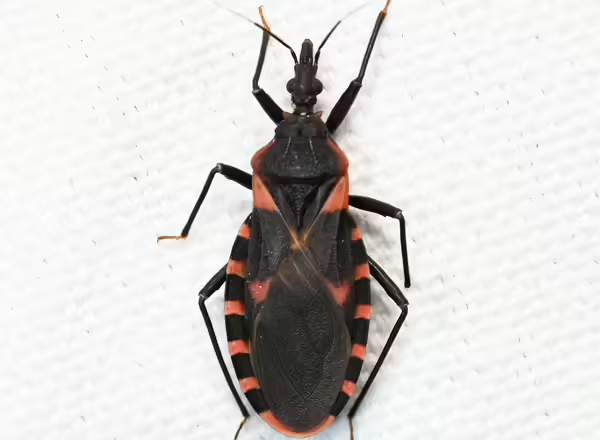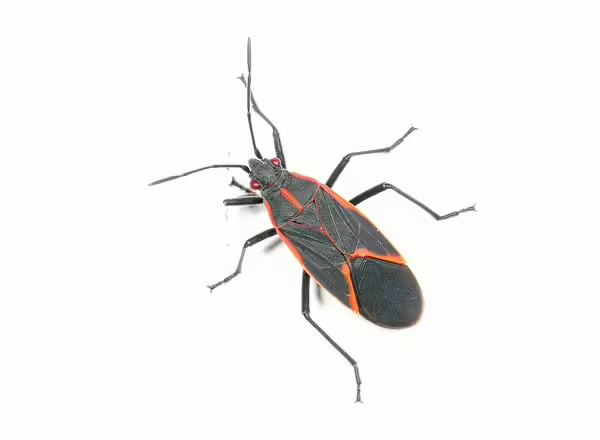
Kissing bugs are present in Illinois, but the risk of contracting a disease from them is low. While Chagas disease has been confirmed in animals, there have been no cases of humans acquiring Chagas disease while in Illinois (as of September 2025).
What are kissing bugs?
Kissing bugs, also known as triatomine bugs, are a type of assassin bug (family Reduviidae) that, unlike most assassin bugs, feed on the blood of (primarily) mammals, such as raccoons, armadillos, opossums, wood rats, squirrels, dogs, and humans. They get the name kissing bug because when feeding on humans, they often feed near the person's lips or eyes (this is not the only place they may feed, though).
These bugs are nocturnal; during the day, they are commonly found in animal nests or burrows, as well as in brush piles, under tree bark, and other out-of-the-way locations. They may occasionally also be found in wall and roof cracks and places like chicken coops.
Kissing bugs go through incomplete metamorphosis (egg, nymph, and adult). Kissing bugs will go through several nymphal stages and must feed before advancing to the next stage, which is why they are commonly found near their hosts. After maturing into adults, they will continue to feed on blood. Adult females need a blood meal to lay eggs.

Kissing bugs in Illinois
There are two species of kissing bugs found in Illinois, the bloodsucking conenose, Triatoma sanguisuga, and T. lecticularia. The bloodsucking conenose is the most commonly encountered. They are found primarily in the southern half of the state (there has only been one found north of Peoria and McLean counties).
Bloodsucking conenose adults are approximately ¾ in long, with dark brown to black, flattened bodies and long, cone-shaped heads. Their wide abdomens extend beyond their wing margins and have reddish-orange spots along the side.
Chagas disease
Kissing bugs serve as the vector for the pathogen (protozoan parasite) that causes Chagas disease (Trypanosoma cruzi). Chagas disease has an acute and chronic phase. In the acute stage (shortly after transmission), people may or may not have symptoms, which can include fever, rash, and swelling of the bite area. In the chronic stage, people may develop heart and digestive problems.
Chagas disease is not transmitted by kissing bugs biting and feeding; rather, the pathogen is present in their feces. After feeding, kissing bugs will defecate, and if the area is scratched or rubbed, the pathogen can get into the feeding wound, eyes, etc.
Chagas disease is primarily a concern in Central and South America. This is because the pathogen is much more prevalent, kissing bugs are often in close contact with humans (they are often found in homes), and several of the kissing bug species will defecate shortly after feeding.
While the Chagas disease pathogen has been found in Illinois, there have been no cases of locally acquired Chagas disease in the state (people with Chagas disease have traveled to Central and South America). While the Bloodsucking conenose is capable of carrying the pathogen that causes Chagas disease, transmission in Illinois is unlikely due to the fact that the disease is not very prevalent, the bugs do not often come into contact with humans, and these bugs take longer to defecate after feeding than other species do (making it less likely they will defecate on their host).
Kissing bug look-alikes
There are several different insects that are commonly confused with kissing bugs.
- Wheel bugs (Arilus cristatus) are probably the insects most commonly misidentified as kissing bugs. They can be differentiated from kissing bugs because of the cog-like wheel on their thorax.
- Western conifer seed bugs (Leptoglossus occidentalis) are similar in size to kissing bugs, but they have flattened areas on their hind legs that look similar to leaves (kissing bug legs are skinny).
- Squash bugs (Anasa tristis) are also similar in size and shape to kissing bugs; however, their coloration is different, and they do not have an elongated head.
- Boxelder bugs (Boisea trivittata) are occasionally confused with kissing bugs; however, they are smaller and have three reddish stripes on their thorax (bloodsucking conenose does not).




Managing kissing bugs
To keep kissing bugs out of homes, take the same steps as you would to keep other home invaders.
- Make sure windows and doors fit tightly, and make sure window screens don't have any holes in them.
- Seal any openings, cracks, and crevices around the foundation, pipes, wires, and chimneys.
- Finally, make sure siding, eaves, and soffits are in good condition.
- Kissing bugs are also attracted to lights and will fly to outdoor lighting. Turning off outdoor lighting or putting them on timers or motion detectors can reduce the chances of them coming to homes.
Good Growing Fact of the Week: According to Texas A&M University, eleven different species of kissing bugs are found in the United States. Texas, New Mexico, and Arizona have the most species and findings of kissing bugs.
References and for more information
Beatty, N. L., Hamer, G. L., Moreno-Peniche, B., Mayes, B., & Hamer, S. A. 2025. "Chagas Disease, an Endemic Disease in the United States." Emerging Infectious Diseases, 31(9), 1691-1697. https://doi.org/10.3201/eid3109.241700.
Killets, Keswick C., Jillian Wormington, Italo Zecca, Luis Fernando Chaves, Gabriel L. Hamer, and Sarah A. Hamer. 2025. "Comparative Feeding and Defecation Behaviors of Trypanosoma Cruzi-Infected and Uninfected Triatomines (Hemiptera: Reduviidae) from the Americas." Insects 16 (2): 188. https://doi.org/10.3390/insects16020188.
Klotz, Stephen A, Patricia L Dorn, Mark Mosbacher, and Justin O Schmidt. 2014. "Kissing Bugs in the United States: Risk for Vector-Borne Disease in Humans." Environmental Health Insights 8 (Suppl 2): 49–59. https://doi.org/10.4137/EHI.S16003.
Santos, Ellen M, Catherine D Santanello, Rachel Curtis-Robles, Keswick Killets, Gena Lawrence, Jet Sevenshadows, Meredith J Mahoney, Molly Baker, and Sarah A Hamer. 2023. "The Distribution of Triatomine (Hemiptera: Reduviidae) Vectors of Trypanosoma Cruzi (Kinetoplastida: Trypanosomatidae) in Illinois and Missouri: Historical Records and Specimen Submissions from Community Science Programs." Journal of Medical Entomology 61 (6): 1273–81. https://doi.org/10.1093/jme/tjad124.
Vandermark, Cailey, Elliott Zieman, Esmarie Boyles, Clayton K Nielsen, Cheryl Davis, and Francisco Agustín Jiménez. 2018. "Trypanosoma Cruzi Strain TcIV Infects Raccoons from Illinois." Memórias Do Instituto Oswaldo Cruz 113 (1): 30–37. https://doi.org/10.1590/0074-02760170230.
Photos
Bloodsucking conenose - Amber M. King, CC BY 4.0, iNaturalist
Wheel bug - "Wheel bug (Arilus cristatus)" (Public Domain) by AssateagueNPS
Western conifer seed bug – Itu, CC BY-SA 3.0, https://commons.wikimedia.org
Squash bug - Christina Butler, CC BY 2.0, https://commons.wikimedia.org
Boxelder bug - "Easter" Boxelder Bug - Boisea trivittata" (CC BY 2.0) by Judy Gallagher
Want to get notified when new Good Growing posts are available? SIGN ME UP!
Give us feedback! How helpful was this information (click one): Very helpful | Somewhat helpful | Not very helpful
MEET THE AUTHOR
Ken Johnson is a Horticulture Educator with University of Illinois Extension, serving Calhoun, Cass, Greene, Morgan, and Scott counties since 2013. Ken provides horticulture programming with an emphasis on fruit and vegetable production, pest management, and beneficial insects. Through his programming, he aims to increase backyard food production and foster a greater appreciation of insects.